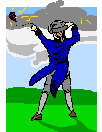BEN'S KITE FLYING DAYS
 Ben Franklin is most famous for his kite flying experiment he performed with his son in 1752. They raised a silk kite on a long cord into a sky filled with black clouds. A metal rod was bound to the kite, and an iron key was attached to the end of the cord. Franklin and his son then tied a silk string to the end of the cord, where the key was, and held onto the silk string.
Ben Franklin is most famous for his kite flying experiment he performed with his son in 1752. They raised a silk kite on a long cord into a sky filled with black clouds. A metal rod was bound to the kite, and an iron key was attached to the end of the cord. Franklin and his son then tied a silk string to the end of the cord, where the key was, and held onto the silk string.
 As the storm clouds approached, the metal rod drew electricity, what Franklin called "electric fire", from them. When the rain wet the kite and the cord, electricity was conducted because of the water from the rod to the key. When Franklin touched the key he received a shock. This proved his theory that lightning was a form of electricity. He knew enough about electricity to end the experiment before the storm got any closer and warned others not to imitate him.
As the storm clouds approached, the metal rod drew electricity, what Franklin called "electric fire", from them. When the rain wet the kite and the cord, electricity was conducted because of the water from the rod to the key. When Franklin touched the key he received a shock. This proved his theory that lightning was a form of electricity. He knew enough about electricity to end the experiment before the storm got any closer and warned others not to imitate him.
 Several people did successfully try Ben's kite experiment in France, England, Russia, and Belgium. However, Professor George Wilhelm Richmann was not so lucky. He was electrocuted in 1753. So kids, DON'T TRY THIS!!!
Several people did successfully try Ben's kite experiment in France, England, Russia, and Belgium. However, Professor George Wilhelm Richmann was not so lucky. He was electrocuted in 1753. So kids, DON'T TRY THIS!!!
BEN - THE INVENTOR
 Being practical with his new found knowledge Franklin invented the lightning rod to be placed on rooftops to lead the lightning strikes harmlessly into the ground. This popular invention in the 1750's did not make Ben Franklin rich; he sought no patents and allowed anyone to copy his plans.
Being practical with his new found knowledge Franklin invented the lightning rod to be placed on rooftops to lead the lightning strikes harmlessly into the ground. This popular invention in the 1750's did not make Ben Franklin rich; he sought no patents and allowed anyone to copy his plans.
UNPOPULAR BEN
 Many believed that lightning was a sign of God's anger and felt it was wrong to interfere with this expression of Godly displeasure. Ben's invention was unpopular in many religious circles.
Many believed that lightning was a sign of God's anger and felt it was wrong to interfere with this expression of Godly displeasure. Ben's invention was unpopular in many religious circles.
 Others worried that directing the lightning into the ground would cause earthquakes. When an earthquake struck Boston in 1755 many blamed lightning rods that had been installed for the disaster.
Others worried that directing the lightning into the ground would cause earthquakes. When an earthquake struck Boston in 1755 many blamed lightning rods that had been installed for the disaster.